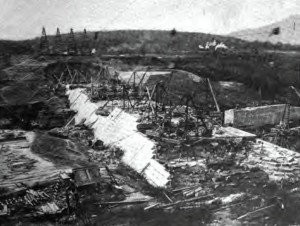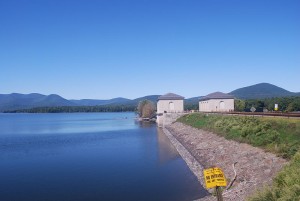Acorn Hill, Catskills Mountains
Through a hole in the fence we entered the wilderness. With countless fallen tree branches and slippery mossy stones jutting out the ground, we needed to be as swift as a deer to jump over the obstacles. It is a paradox that we could not really act like a deer, because the nearby hunters thinking we were deers might mistakenly shoot us. This trek fitted perfectly with a stereotype regarding to archaeology–archaeologists are always accompanied by mysterious forests, poisonous bugs, and hands full of dirt. We were in a forest, we had dirty hands, but no bugs, if frogs did not count, probably because we all had sprayed ourselves before. However, the excitement of going on my very first real field trip dissipated all the concerns and made me enjoy it.
Askohan Reservoir in the Catskills Mountains, lying ninety-three miles north of New York City, was completed in 1915 to provide clean water for the city. While water was transporting through ninety-two miles long aquaducts to slake the thirst of New York City, eleven towns and thousands of arces of farmlands were vanished underwater. Hoping to know how the construction of Askohan Reservoir affected local people’s lives and reshaped rural landscapes, we were here.

Olivebridge Dam under construction to build the Ashokan Reservoir circa 1910.
Finally, we reached the site marked by a washing machine in 1940s, and spilt into three groups to start working. Two groups were dealing with a sampling unit, with each of the three members in a group responsible for different jobs, describing the artifacts, writing down the descriptions, and drawing pictures in the notebook. Instead of staying motionless beside the unit, my group with Dr. Beisaw walked around to gain a better understanding of the adjacent area. There were several piles of stones not far away, on which scattered all kinds of glass, ceramics, metal cans and even shoes. According to Dr. Beisaw, these piles of stones were remains of houses of domestic people, while the bigger piles of soil to the right were industrial records of the exploitation of bluestone in quarry for the construction of the dam over the reservoir. Moving on, we were amazed by a huge man-made platform of stone about six feet high, because there used to be a entire mountain of stone over fifty feet, which completely disappeared after being quarried. At last, we drew a simple map of the area near the sampling unit and highlighted the piles of stone and soil, road and quarry.
During the field trip, what I enjoyed the most is to listen to the stories of every artifact, feature, and ecofact I encountered. They are alive. Trees were not only trees. Their composition and postion suggested that this was a farmland before being abandoned. Stones were not only stones. Their size and shape showed that some were walls to mark the rim of the farmland, some were to support domestic houses. The miscellany of artifacts told a more comprehensive story. Dining ceramics and a metal pan embodied that people were cooking on their own and eating near the quarry. Perfume and nail polish bottles manifested that some people here were in families. Archaeologists cherish the information more than the value in artifacts, because with information, they can reconstruct the past society. Even when you took a piece of gold to an archaeologist, the typical answer would be, according to Dr. Beisaw, “Gold? So what? Give me information!”
______________________________
Search result of Ashokan Reservoir, http://en.wikipedia.org/wiki/Ashokan_Reservoir
A.J.Loftin, The Ashokan Reservoir: The creation of the Ashokan Reservoir changed the Catskills forever, http://www.hvmag.com/Hudson-Valley-Magazine/August-2008/History-The-Ashokan-Reservoir/
Image 2: http://en.wikipedia.org/wiki/File:Olivebridge_Dam_Under_Construction.jpg
Imagej3j:http://commons.wikimedia.org/wiki/File:Ashokan_Reservoir_from_Monument_Road_3.JPG



Dr. Beisaw’s exclamation that gold doesn’t matter, only information (a great quote, by the way) speaks to the importance of context in archaeological study. For instace, the artifact scatters you mentioned here – ceramics, the washing machine, bottles, metal cans, and even nail polish – can only tell us about the past when they are considered together. When we consider where we found them, and near which other objects, the artifacts gave the picture of a domestic site – many of the other fieldworkers remarked that they could easily visualize the house because the artifacts were so similar to what they would find in their own homes. The purpose of your exploration of the nearby area was just as important – since the site was near the large quarry complex you described, who was likely to have lived in this house and bought these items? A single man who worked at the quarry? A married couple? A family? What was their economic situation likely to have been like, given that none of their dishes or glassware matched? Did they buy secondhand goods, rely on gifts from others, or use mismatched items because they couldn’t afford a set? When you start to ask these questions, it becomes clear that even the simplest artifact, when considered in context, contains a wealth of information – you need only notice it!
What you saying reminds me of a detective on a crime scene. The first thing for a detective to do is to explore the crime area and find out as many clues as he can, just like us looking for scattered artifacts. Then he needs to piece together every information and form a coherent hypothesis, the same to your saying that artifacts give a picture of domestic life when considered together. However, in this process, it is hard to believe that a detective analyzes clues for their internal connections without actually searching all possible resources in a wide range of background knowledge. That is what I lack. I do not know much knowledge about the quarry and the domestic people, so even if I see many artifacts and features, I can not deduce the right functions and meanings from them. A single man, a couple, a family are all possible suggestions to me. I do not really know how to see the fact with little background knowledge.
It is also hard to find a relevant link, though.